Monumental myths: Darkness beckons in Anselm Kiefer's Walhalla
25 November 2016
WILLIAM COOK visits Anselm Kiefer's new exhibition Walhalla, a monument to ideas of German history and myth featuring a lead-lined dormitory full of lead sheets and pillows, and a series of large-scale paintings covered in molten metal.

When you step inside Anselm Kiefer’s new show, at London’s White Cube gallery, the first thing that hits you is the darkness. But this darkness isn’t normal – there’s something sinister about it. It’s like the beginning of a horror film. You know something terrible has happened here, but you don’t know what it is.
From the wallpaper to the pillow cases, everything you can see in here is made entirely out of lead
You’re standing in a long corridor, lit by a few bare light bulbs. As your eyes adjust to the gloom, you are aware you’re surrounded by unmade beds. It’s like a prison sanatorium, or a sickbay in a lunatic asylum. Everything is metallic grey: the walls, the floor, the ceiling - even the bed-linen. Then you realise what’s so odd about this place, what makes it feel so spooky. From the wallpaper to the pillow cases, everything you can see in here is made entirely out of lead.
As you walk along this corridor, you recognise these beds have all been slept in. The metal sheets are crumpled. Where have all the people gone? Finally, you reach the end of the corridor and a doorway into a whitewashed gallery. Sunshine streams through the windows. In front of you is a painting of the sun rising over a field of wild flowers. It’s like the difference between night and day.
Anselm Kiefer has spent his life in the long shadow of the Third Reich. He was born in Germany in 1945 and grew up in a defeated Fatherland, in the desolate aftermath of the Second World War. Germany was disgraced and devastated. Hitler’s dreadful legacy hung over every aspect of daily life.
Yet when Kiefer was growing up the Holocaust was never mentioned. Kiefer thought this was crazy and through his art he set out to change it. Today the crimes of the Third Reich are acknowledged throughout Germany. Kiefer was part of a generation of German artists who forced Germany to confront its past.


Kiefer spent his childhood in the Black Forest, a provincial upbringing with few distractions. "I grew up in a village," he says. "We had no television, no entertainment." Whereas his own children have grown up bombarded by the mass media, this isolation encouraged him to cultivate his own vision. "I was bored, but in a good way," he says. "This boredom, this emptiness, is very helpful."
We had no television, no entertainment.. I was bored, but in a good way. This boredom, this emptiness, is very helpful.Anselm Kiefer
Today, Kiefer is one of Europe’s most renowned and respected artists. His 2014 retrospective at London’s Royal Academy was a sensation, and so was his retrospective at the Pompidou in Paris this year. However, specific shows like this one are a lot closer to his heart.
Its title is Walhalla, after the Walhalla Monument in Bavaria, a bombastic mausoleum built to honour the national heroes of German history. Like so much of Kiefer’s work, this title has many meanings. Valhalla is the Viking heaven, reserved for warriors who’ve died in battle. These warlike myths were appropriated by Wagner, and later by the Nazis.
Kiefer was inspired by Wagner as a teenager – he can still recall the first time he heard him, on the radio, when he was fourteen – but he recognises that this great composer was a violent anti-Semite.
Similar ambiguities are reflected in this magnificent, disturbing show. Kiefer’s Walhalla is a monument to hubris. Walking through these galleries feels like wandering around the ruins of Dresden.

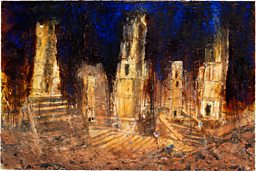
Anselm Kiefer on Front Row
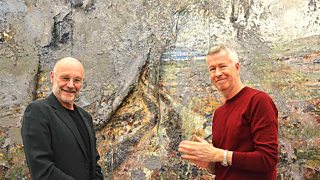
You cannot kill mythology. It goes on, sometimes in a very bad way.
In a rare interview, Anselm Kiefer discusses Walhalla, the German psyche, the rise of populism in European politics and his use of lead, with John Wilson on Radio 4's Front Row.
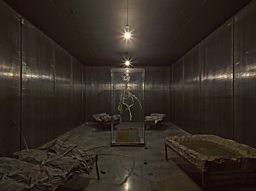
Kiefer is a painter and a sculptor, but the boundary between these disciplines is blurred. His scrapyard sculptures are splattered with paint; his use of paint is almost sculptural. Superficially it looks chaotic, but it is actually remarkably controlled. He makes art out of junk and refuse: ragged old clothes, rusty old bicycles - the sort of useless rubbish most of us would throw away. These scruffy artworks can be beautiful, but an air of doom and danger is never far away.
Although his work is harrowing, like all great art it is exhilarating
Kiefer’s paintings evoke the barren landscapes of bombed-out cities. His sculptures evoke the horrors of the concentration camps. If you think this sounds grim, you’d be right. Yet although his work is harrowing, like all great art it is exhilarating - even when the subject matter is so bleak.
The German philosopher Theodor Adorno said that to create poetry after Auschwitz would be barbaric. For poetry, read art. Ever since the Second World War, this has been a huge problem for German artists of every genre. How can you ignore something as colossal as the Holocaust? Yet how can you confront it? Somehow, Kiefer has found a style which fits.
How has he managed it? His use of found objects is part of it. His immense sense of scale also helps. But above all, it’s because his monumental artworks are deliberately enigmatic. You’re left to draw your own conclusions about what they’re all about. Their central message seems to be that war and suffering are inescapable, that humanity is innately violent and destructive - but you don’t have to see them that way.
Some people see Auschwitz in these images, other people see Aleppo. Some people simply see stunning abstract works of art. "I always allow people to see what they want to see," says Kiefer. "Anyone who sees the painting has another painting in his head."
• Walhalla by Anselm Kiefer is at White Cube, London until 12 February 2017.


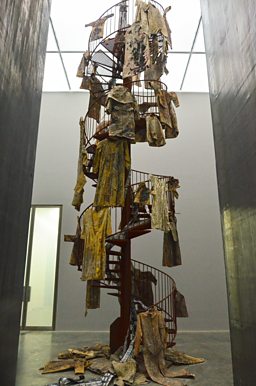
More Anselm Kiefer
-
![]()
Royal Academy
Kiefer 's first major British retrospective, at the Royal Academy in 2014
Related Links
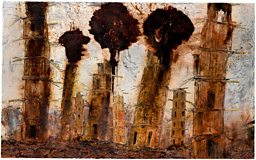
More from BBC Arts
-
![]()
Picasso’s ex-factor
Who are the six women who shaped his life and work?
-
![]()
Quiz: Picasso or pixel?
Can you separate the AI fakes from genuine paintings by Pablo Picasso?
-
![]()
Frida: Fiery, fierce and passionate
The extraordinary life of Mexican artist Frida Kahlo, in her own words
-
![]()
Proms 2023: The best bits
From Yuja Wang to Northern Soul, handpicked stand-out moments from this year's Proms





